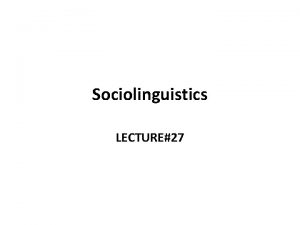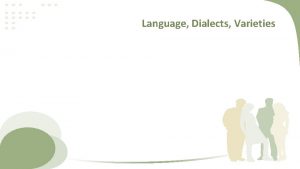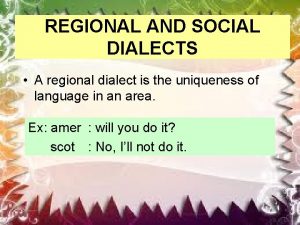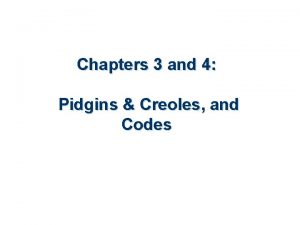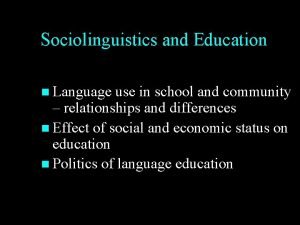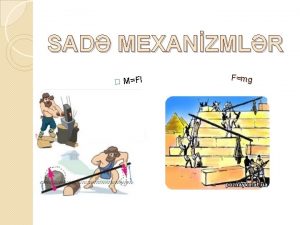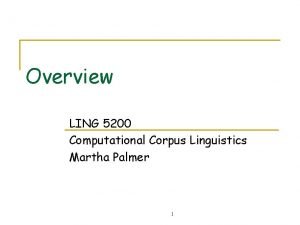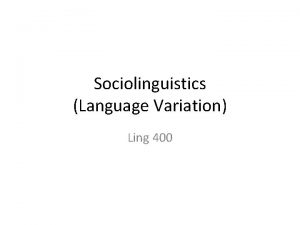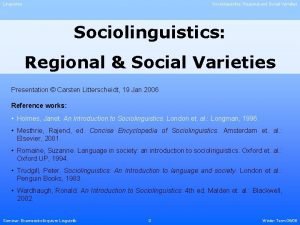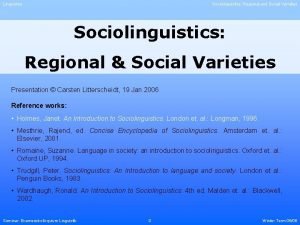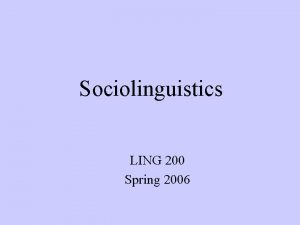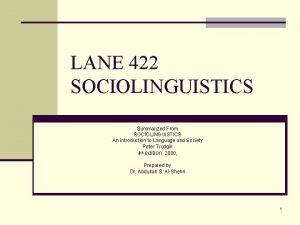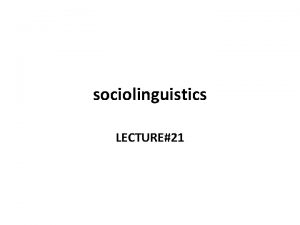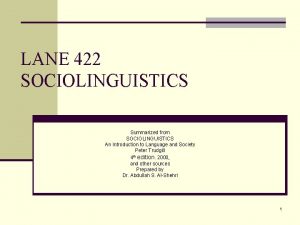LING 101 SOCIOLINGUISTICS 2 Standard and NonStandard Language











- Slides: 11

LING 101 SOCIOLINGUISTICS 2. Standard and Non-Standard Language Varieties

Regional variation Style of speech in one particular area of a country. The nature of regional dialects May be conservative or innovative to greater or lesser degree Distinct ‘accent’ Grammar differences Vocabulary for local features Local words for items available nationally

Origin of regional dialects General principles of language a. all speech contains variation b. language is always changing Historical process of development into separate dialects a. community splits b. language differences develop different variants win out in different locations c. result - different dialects Natural boundaries Mountains, sheer distance, lack of mobility, deliberate isolation dialects > mutually unintelligible (separate languages)

Social variation A. social dialects caused by social boundaries B. small scale society 1. Members resemble each other Share major characteristics Identify as members of society as a whole Status differences based on individual capabilities, not on social roles

Speech variation a. stylistic variation b. random non-standardized variety high degree of variation which has no social meaning c. no variation that corresponds to status differences

More complex society 1. stratified/divided community 2. members belong to saliently different groups 3. social divisions become encoded in language a. language will change differently in different social groups i. contact is limited across groups ii. limited motivation to adopt language differences have social functions solidarity status

Motivation Social functions motivate people to speak like other members of their group The degree of individual’s personal identification with group modifies speech behavior central group member peripheral group member b. doesn’t generally lead to mutual unintelligibility

Standardization One dialect recognized as the standard; used by media, education, government, socio-economic elite Origin of standard 1. standardization is a natural social /linguistic process 2. Regional standard i. differentiation ii. status shift stage 1 - relatively equal status of different geographic regions stage 2 - one region becomes politically, economically dominant dialect of dominant group carries prestige of that group

Dominance Historical accident as to which region becomes dominant English - variety of London - capitol French - variety of Paris - capitol German - variety of first German translations of Bible iv. therefore historical accident which dialect becomes standard does not start out in any way superior to others, but it is the one that gets codified The remainder other dialects seen as deficient by comparison

Social standard a. differentiation small scale society becomes complex, stratified social groups develop separate dialects b. status shift dialect of economically, politically dominant group takes on prestige of that group over time comes to be considered superior Standard and non-standard dialect difference? Mainly socio-political Consequence? Serious socioeconomic implications of speaking a non-standard variety

Two main social language perspectives a. Descriptive reflects linguistic reality all dialects are linguistically equal scholars describe what any and all forms of a language are like b. Prescriptive reflects social reality result of the influence of standardization and personal beliefs experts teach people how to speak ‘correctly’
 Standard and nonstandard english examples
Standard and nonstandard english examples Differences between home language and standard language
Differences between home language and standard language Non standard cell potential
Non standard cell potential Language dialect and varieties in sociolinguistics
Language dialect and varieties in sociolinguistics Language
Language A regional dialect
A regional dialect Pidgin and creole in sociolinguistics
Pidgin and creole in sociolinguistics Sociolinguistics and education
Sociolinguistics and education Jin ling cigarettes
Jin ling cigarettes Sadə mexanizmlər
Sadə mexanizmlər Ling
Ling Erin ling
Erin ling



